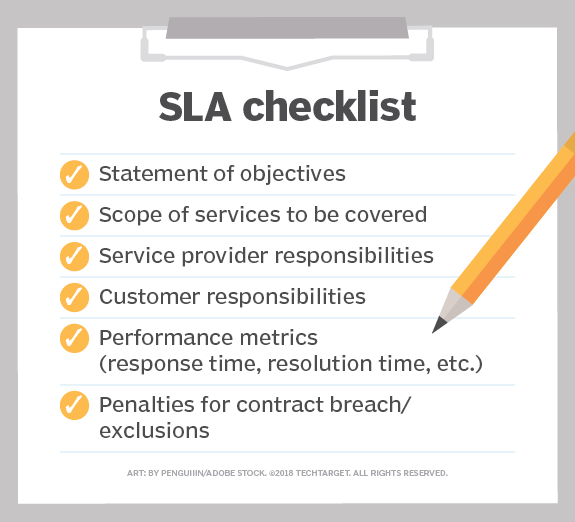Service-Level Agreement (SLA)
A service-level agreement (SLA) is a contract between a service provider and its internal or external customers that documents what services the provider will furnish and defines the service standards the provider is obligated to meet.
Why are SLAs important?
Service providers need SLAs to help them manage customer expectations and define the circumstances under which they are not liable for outages or performance issues. Customers can also benefit from SLAs in that they describe the performance characteristics of the service, which can be compared with other vendors’ SLAs, and also set forth the means for redressing service issues — via service credits, for example.
For a service provider, the SLA is typically one of two foundational agreements it has with customers. Many service providers establish a master services agreement to establish the general terms and conditions in which they will work with customers. The SLA is often incorporated by reference into the service provider’s master services agreement. Between the two service contracts, the SLA adds greater specificity regarding the services provided and the metrics that will be used to measure their performance.
What goes into an SLA?
In broad terms, an SLA will typically include a statement of objectives, a list of the services to be covered by the agreement and will also define the responsibilities of the service provider and customer under the SLA.
The customer, for example, will be responsible for making a representative available to resolve issues with the service provider in connection with the SLA. The service provider will be responsible for meeting the level of service as defined by the SLA. The service provider’s performance is judged according to a set of metrics. Response time and resolution time are among the key metrics included in an SLA, since they relate to how the service provider deals with a service interruption.

Performance metrics
SLAs establish customer expectations with regard to the service provider’s performance and quality in a number of ways. Some metrics that SLAs may specify include the following:
- Availability and uptime percentage — the amount of time services are running and accessible to the customer. Uptime is generally tracked and reported on per calendar month.
- Specific performance benchmarks to which actual performance will be periodically compared.
- Service provider response time — the time it takes the service provider to respond to a customer’s issue or request. A larger service provider may operate a service desk to respond to customer inquiries.
- Resolution time — the time it takes for an issue to be resolved once logged by the service provider.
- The schedule for notification in advance of network changes that may affect users.
- Usage statistics that will be provided.
An SLA may specify availability, performance and other parameters for different types of customer infrastructure — internal networks, servers and infrastructure components such as uninterruptable power supplies, for example.
Penalties: Repercussions for breaking terms
In addition to establishing performance metrics, an SLA may include a plan for addressing downtime and documentation for how the service provider will compensate customers in the event of a contract breach. Service credits are a typical remedy. Here, the service provider issues credits to the customer based on an SLA-specified calculation. Service providers, for example, might provide credits commensurate with the amount of time it exceeded the SLA’s performance guarantee. A service provider may cap performance penalties at a maximum dollar amount to limit exposure.
The SLA will also include a section detailing exclusions, that is, situations in which an SLA’s guarantees — and penalties for failing to meet them — don’t apply. The list might include events such as natural disasters or terrorist acts. This section is sometimes referred to as a force majeure clause, which aims to excuse the service provider from events beyond its control.
Who needs a service-level agreement?
SLAs are thought to have originated with network service providers, but are now widely used in a range of IT-related fields. Companies that establish SLAs include IT service providers, managed service providers and cloud computing service providers. Corporate IT organizations, particularly those that have embraced IT service management (ITSM), enter SLAs with their in-house customers — users in other departments within the enterprise. An IT department creates an SLA so that its services can be measured, justified and perhaps compared with those of outsourcing vendors.
Types of SLAs: Evolution
Over the years, SLAs have expanded to govern a growing set of IT procurement models. When IT outsourcing emerged in the late 1980s, SLAs evolved as a mechanism to govern such relationships. SLAs set the expectations for a service provider performance and established penalties for missing the targets and, in some cases, bonuses for exceeding them. Since outsourcing projects were frequently customized for a particular customer, outsourcing SLAs were often drafted to govern a specific project.
As managed services and cloud computing services became more prevalent in recent years, SLAs evolved to address those approaches. Shared services, rather than customized resources, characterize the newer contracting methods, so SLAs tend to be broad agreements intended to cover all of a service provider’s customers.
SLAs, regardless of type, are subject to modification over time. Service providers will periodically review and update SLAs to reflect the addition of new services, changes to existing services or changes in the overarching regulatory environment.